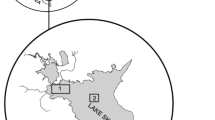Abstract
Despite the common occurrence of ontogenetic niche shifts, their consequences for morphological adaptations have been little studied. To address this question, we studied morphological adaptations related to ontogenetic niche shifts in Eurasian perch (Perca fluviatilis) in eight lakes that varied in density of benthic resources and planktivorous fish biomass. Perch start to feed on pelagic zooplankton, then shift to benthic resources at intermediate sizes, and finally, when large enough, mainly feed on fish. These three functional niches over ontogeny are expected to set constraints on the morphology and size-specific growth of perch. The growth of perch was negatively related to planktivorous fish biomass in the zooplanktivorous niche, but positively related to planktivorous fish biomass in the piscivorous niche. The number of gill rakers of perch was negatively related to the biomass of planktivorous fish, providing evidence for the occurrence of character displacement as a consequence of competition in the zooplanktivorous niche. Perch in lakes with low densities of predator-sensitive macroinvertebrates had greater body height measurements and a larger mouth early during ontogeny. This pattern is suggested to be a result of a selection for increased efficiency in the benthic niche when the availability of benthic resources is low. Perch in lakes with a high biomass of planktivorous fishes had fusiform body morphology, a thicker tail and a larger mouth then the average piscivorous perch. The different responses of perch morphology to variation in the availability of benthic resources compared to variation in planktivore biomass are suggested to be partly because the availability of the former resource to a larger extent is set by abiotic conditions (humic content). We suggest that the key factors affecting size-specific growth and body morphology of perch in the system studied are the availability of resources in the benthivorous and piscivorous niches. We also provide evidence for morphological trade-offs, especially between the benthivorous and the piscivorous ontogenetic niches.
Similar content being viewed by others
Author information
Authors and Affiliations
Additional information
Received: 6 July 1999 / Accepted: 8 September 1999
Rights and permissions
About this article
Cite this article
Hjelm, J., Persson, L. & Christensen, B. Growth, morphological variation and ontogenetic niche shifts in perch (Perca fluviatilis) in relation to resource availability. Oecologia 122, 190–199 (2000). https://doi.org/10.1007/PL00008846
Issue Date:
DOI: https://doi.org/10.1007/PL00008846




